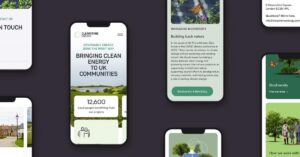If you ask most people what’s ruining the planet, they’ll probably point to coal plants, gas-guzzling SUVs, and plastic in the ocean. Few would think of blaming their favorite e-commerce store, streaming habits, or website they built five years ago and forgot about. Yet, the internet is one of the largest invisible polluters on Earth. It’s a silent energy consumer, growing exponentially, and every click, search, and video stream has a carbon footprint.
I’ve spent years covering tech innovations, but it wasn’t until I stumbled upon some shocking numbers that I realized how massive the internet’s energy demands are. Every website we visit, every Instagram scroll, and every “forgotten” webpage sitting on a server somewhere contributes to an ever-growing environmental impact. Here in Columbia, South Carolina, businesses are starting to take notice, with Web Design Columbia leading the charge in creating websites that function beautifully and minimize their digital footprint.

This isn’t just a niche concern for environmental activists; it’s a global issue. The digital world is expanding at breakneck speed, and a considerable energy cost comes with it. But here’s the real kicker—unlike coal plants and car emissions, most people don’t even know it’s happening. So, let’s break it down: how exactly does the web contribute to pollution, what are companies doing about it, and is green web design the answer we need?
The Internet’s Dirty Little Secret: The Hidden Energy Drain of Websites
Most of us think of the internet as a virtual space—floating in the cloud, detached from the physical world. But that cloud is very much tethered to reality, and it’s powered by massive data centers that consume staggering amounts of electricity. According to the International Energy Agency (IEA), data centers worldwide consume about 200 terawatt-hours (TWh) of electricity annually. To put that into perspective, that’s nearly as much electricity as the entire country of Spain uses in a year.
It’s not just the big names like Google, Amazon, and Facebook fueling this consumption. Every website, no matter how small, leaves an environmental mark. Every image, video, and line of code requires server space, and servers require cooling. That’s why website design in Columbia, SC, is shifting toward energy-efficient solutions. Businesses are waking up to the reality that their digital presence has a real-world impact.
Streaming services alone account for an enormous share of this energy use. Watching Netflix for just one hour emits roughly 36g of CO2—multiply that by the millions of users binge-watching nightly, and you start to see the problem. Even simple actions like sending an email aren’t as harmless as they seem. A standard email produces about 4g of CO2, but if it has a large attachment, that number jumps to 50g. A year’s worth of unnecessary emails could be equivalent to driving a car several miles.
So, where does all this energy come from? Much of it is still sourced from fossil fuels. Despite efforts by tech giants to transition to renewable energy, a large percentage of data centers worldwide are still powered by coal and natural gas.
Green Hosting and Sustainable Web Design: Can We Really Make a Difference?
The good news is that many companies are stepping up. Green web hosting is one of the most promising solutions, allowing businesses to reduce their websites’ energy footprint without sacrificing performance. Green hosting providers like GreenGeeks, Kualo, and SiteGround use renewable energy to power their data centers or invest in carbon offsets to balance emissions.
Website design in Columbia, SC, is seeing a rise in interest in these eco-friendly solutions, especially from businesses looking to align with sustainability goals. Web Design Columbia has been helping companies transition to green hosting, optimizing their websites to consume less energy while maintaining fast load speeds.
However, not all green hosting providers are created equal. Some merely buy Renewable Energy Certificates (RECs) without actually reducing their energy consumption, leading to accusations of greenwashing. While carbon offset programs are a step in the right direction, they don’t eliminate the core problem: an internet that continues to grow in energy consumption.
Another primary strategy is reducing unnecessary data transfer. Every time a webpage loads, data is sent from a server to a user’s device. The larger the webpage, the more energy is required. In 2023, the average website was over 2MB in size—double what it was just a few years ago. A bloated website with high-resolution images, auto-playing videos, and heavy scripts consumes significantly more energy than a well-optimized, lightweight site.
This is where green web design principles come in. Sustainable web design isn’t just about switching to green hosting—it’s about rethinking how we build and structure websites. Techniques like lazy loading, efficient caching, and next-gen image formats (like WebP) can dramatically reduce energy consumption.
But there’s a trade-off. Many website owners resist compressing images or removing unnecessary features because they worry about aesthetics or user experience. While a minimalist website might be faster and more eco-friendly, some businesses fear it won’t look as engaging.

Big Tech’s Role: Are They Leading or Just Greenwashing?
The world’s largest tech companies are both part of the problem and key players in the solution. Google, Amazon, and Microsoft have all committed to ambitious sustainability goals, but their impact varies.
Google claims its carbon-neutral data centers will run entirely on carbon-free energy by 2030. Meanwhile, Amazon Web Services (AWS), which hosts a significant portion of the Internet, invests heavily in wind and solar farms. However, critics argue that these companies still operate in regions with prevalent coal-powered electricity, meaning their environmental footprint is far from zero.
For its part, Microsoft has pledged to be carbon-negative by 2030, meaning it plans to remove more carbon from the atmosphere than it emits. However, even the best green initiatives face challenges. Some experts believe that as AI and machine learning become more prevalent, data centers’ energy consumption will only increase, potentially offsetting these green gains.
Locally, website design in Columbia,, SC,, is seeing more businesses push for transparency from hosting providers and software platforms. Clients want to know whether their companies are committed to sustainability or just slapping a green label on their services.
Is Green Web Design the Future or Just a Trend?
With increasing awareness of digital sustainability, green web design will soon be the industry standard rather than an optional extra. But there are hurdles. Many developers and designers aren’t yet trained in sustainable practices, and there’s still a general lack of awareness among business owners.
The rise of artificial intelligence and blockchain technology also presents new energy challenges. AI models like ChatGPT require vast computing power, and Bitcoin mining alone consumes more electricity than some nations. Keeping websites energy-efficient will require constant innovation as the internet becomes more complex.
That’s why companies need to act now. For businesses in Columbia, SC, website design decisions made today will impact their environmental footprint for years to come. Choosing green hosting, optimizing images and scripts, and minimizing unnecessary features can make a real difference—energy savings and cost savings.
The Mobile Web’s Impact: How Phones Are Driving Energy Consumption
If you think websites consume much energy, wait until you factor in mobile devices. The smartphone revolution has completely reshaped how we interact with the internet, with mobile devices now accounting for nearly 60% of global web traffic. While this has made the web more accessible, it has also increased the energy burden.
Every time you load a website on your phone, data is transferred over networks that require massive infrastructure. Mobile networks—especially 4G and 5G—rely on thousands of cell towers, fiber optic cables, and backend servers. A single gigabyte of mobile data transfer can produce up to 5kg of CO2 emissions, which, over time, adds up to an enormous environmental cost.
Website design in Columbia, SC, is increasingly optimized for mobile-first experiences, ensuring that sites are streamlined, lightweight, and efficient. However, not all mobile experiences are created equal. Many websites still suffer from bloated design elements that increase load times and, in turn, drain battery life. A slower website means a user’s device has to work harder, consuming more energy both on the user’s and server’s sides.
One solution is progressive web apps (PWAs), which allow users to interact with a website in an app-like experience without installing a traditional mobile app. PWAs reduce data usage and improve speed and accessibility. Companies like Twitter, Starbucks, and Pinterest have already seen huge benefits from PWAs, reducing their website data loads by up to 70%.
But there’s a downside to all this convenience. While mobile-friendly design is crucial, optimizing for 5G presents new challenges. 5G networks are significantly faster than their predecessors but require much more energy to operate. As the world transitions from 4G to 5G, the power consumption of telecom infrastructure is expected to increase dramatically. Developers must now walk a fine line between performance and sustainability—something that’s easier said than done.
Dark Mode: Trend or Sustainability Hack?
A few years ago, dark mode became one of the biggest UX trends, with major companies like Apple, Google, and Microsoft integrating it into their operating systems and applications. While many users appreciate dark mode for its sleek aesthetic and reduced eye strain, there’s another significant benefit: energy savings.
OLED and AMOLED screens, now standard in most flagship smartphones, consume significantly less power when displaying darker colors. Unlike traditional LCD screens, which use a backlight regardless of what’s on the screen, OLED panels only illuminate the necessary pixels. Thus, a website designed with a darker theme can reduce energy consumption on mobile devices.
But before you go turning everything black, there’s a catch. Dark mode only saves energy on OLED screens—not LCDs. Since many older devices and budget smartphones still use LCD technology, the energy savings from dark mode are not universal. Additionally, research suggests that while dark mode can reduce screen-related power consumption by up to 50% in some cases, its impact on overall internet energy usage is still relatively small.
That said, website design in Columbia, SC, is seeing more businesses experiment with dark mode, not just for sustainability reasons but also for user engagement. Many users prefer dark mode in low-light environments, and having a toggle option for light and dark themes can improve the overall user experience.
Major platforms like YouTube and Reddit have reported increased user retention after implementing dark mode, suggesting that it might also be a wise business decision beyond energy efficiency. However, designers must tread carefully—simply inverting colors isn’t enough. If poorly designed or executed, dark mode can lead to readability issues, contrast problems, and even increased eye strain.
The Role of Minimalist Design in a Sustainable Web
Minimalism isn’t just an aesthetic choice—it’s one of the most effective ways to create energy-efficient websites. By stripping away unnecessary design elements, businesses can build websites that are visually appealing and consume less power.
The trend toward minimalism in website design in Columbia, SC, is driven by functionality and sustainability. A minimalist website loads faster requires less server power, and provides a smoother user experience. Companies like Google and Apple have long embraced minimalism in their digital products, proving that simplicity doesn’t mean sacrificing effectiveness.
But where do we draw the line? While minimalism can improve speed and energy efficiency, it also has limitations. Some websites go too far, removing critical features to create a “clean” look. Too-sparse navigation menus, overly simplified layouts, and excessive whitespace can sometimes make a website feel empty or challenging.
Additionally, minimalist design often relies on typography as a primary visual element. High-quality fonts can be surprisingly resource-intensive, as some web fonts require multiple large file downloads. To counteract this, many designers opt for system fonts—pre-installed like Arial, Times New Roman, or Helvetica—to reduce data load.
There’s also the challenge of balancing branding with minimalism. Some businesses rely on rich, engaging visuals to tell their story, and a stripped-down design might not capture their identity effectively. The key is to find a middle ground—removing clutter without losing personality.
As the web continues to evolve, it’s clear that minimalism isn’t just a passing trend; it’s a necessary shift toward a more sustainable digital world. By focusing on efficiency, businesses can create websites that look great and contribute to a greener internet.
Small Changes, Big Impact
Sustainable web design isn’t about creating the perfect website overnight—it’s about making smarter choices one step at a time. Every business that chooses green hosting, every developer who optimizes code, and every designer who prioritizes efficiency over excess contributes to a greener internet.
Web Design Columbia is here to help if you’re wondering where to start. With nearly two decades of experience and a deep understanding of modern web practices, they specialize in creating websites that are not just visually stunning but also built to minimize environmental impact.
The internet might be one of the world’s biggest polluters, but it’s also one of the easiest to change. So, the next time you launch a new website or redesign an old one, consider how it looks—and how it impacts the planet. The future of web design isn’t just about pixels and code; it’s about sustainability, responsibility, and ensuring that the digital world doesn’t come at the expense of the real one.











